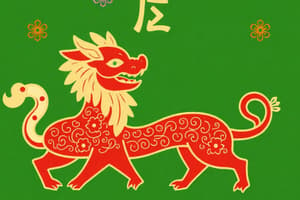Podcast
Questions and Answers
Approximately what percentage of the world's population celebrates Chinese New Year?
Approximately what percentage of the world's population celebrates Chinese New Year?
- One-twentieth
- One-sixth (correct)
- One-quarter
- One-tenth
What is another name for Chinese New Year?
What is another name for Chinese New Year?
- Festival of Lanterns
- Dragon and Rabbit Festival
- Winter Solstice Festival
- Lunar New Year or the Spring Festival (correct)
When did China adopt the Western calendar?
When did China adopt the Western calendar?
- 1912 (correct)
- 2000s
- 1950s
- 1840s
Where is the largest Chinese New Year celebration outside of China?
Where is the largest Chinese New Year celebration outside of China?
What is the significance of the 15th day of the Chinese New Year?
What is the significance of the 15th day of the Chinese New Year?
Why do people clean their houses before Chinese New Year?
Why do people clean their houses before Chinese New Year?
What is the significance of long noodles during Chinese New Year?
What is the significance of long noodles during Chinese New Year?
What is the significance of the color red during Chinese New Year?
What is the significance of the color red during Chinese New Year?
Flashcards are hidden until you start studying
Study Notes
Chinese New Year Celebrations
- Over 1 billion Chinese citizens, approximately a sixth of the world's population, celebrate Chinese New Year.
- The 15-day festival is also known as Lunar New Year or the Spring Festival.
Origins and Dates
- Chinese New Year is based on the ancient Chinese calendar, which existed as early as the 14th century BC.
- The festival falls on the second new moon after the winter solstice, or between January 21st and February 19th according to the Gregorian calendar.
- China adopted the Western calendar in 1912, but Chinese New Year remains the country's most important social and economic holiday.
Global Celebrations
- Chinese New Year festivities have spread beyond China and take place all over the world.
- The largest celebration outside of China takes place in San Francisco, USA, since the 1840s and 50s.
Chinese Zodiac and Traditions
- Each year is named for one of the 12 animals associated with the Chinese Zodiac.
- The dragon and rabbit are particularly important to Chinese New Year, with dragon decorations and rabbit-shaped paper lanterns being prominent symbols.
- The 15th day of the new year is known as the Festival of Lanterns.
Customs and Superstitions
- People clean out their houses to rid them of ghosts and bad luck associated with the old year.
- Many people get a new haircut, close unsettled disagreements, and pay off debts to start the year fresh.
- Families make dumplings together on Chinese New Year's Eve, which is said to bring good fortune to the household.
- Long noodles are a traditional dish, but it's considered unlucky to cut them while eating.
- Red is the color of good luck, while black is often associated with death.
- Wearing red and avoiding black is a common tradition during Chinese New Year.
Chinese New Year Celebrations
- Over 1 billion Chinese citizens, approximately one-sixth of the world's population, celebrate Chinese New Year, also known as Lunar New Year or the Spring Festival.
Origins and Dates
- Chinese New Year is based on the ancient Chinese calendar, which dates back to the 14th century BC.
- The festival falls on the second new moon after the winter solstice, between January 21st and February 19th according to the Gregorian calendar.
- China adopted the Western calendar in 1912, but Chinese New Year remains the country's most important social and economic holiday.
Global Celebrations
- Chinese New Year festivities have spread beyond China and take place worldwide.
- The largest celebration outside of China takes place in San Francisco, USA, since the 1840s and 50s.
Chinese Zodiac and Traditions
- Each year is named for one of the 12 animals associated with the Chinese Zodiac.
- The dragon and rabbit are particularly significant to Chinese New Year, with dragon decorations and rabbit-shaped paper lanterns as prominent symbols.
- The 15th day of the new year is known as the Festival of Lanterns.
Customs and Superstitions
- People clean their houses to rid them of ghosts and bad luck associated with the old year.
- Many people get a new haircut, close unsettled disagreements, and pay off debts to start the year fresh.
- Families make dumplings together on Chinese New Year's Eve, which is believed to bring good fortune to the household.
- Long noodles are a traditional dish, but it's considered unlucky to cut them while eating.
- Red is the color of good luck, while black is associated with death, making wearing red and avoiding black a common tradition during Chinese New Year.
Studying That Suits You
Use AI to generate personalized quizzes and flashcards to suit your learning preferences.




